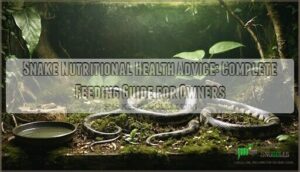This site is supported by our readers. We may earn a commission, at no cost to you, if you purchase through links.

Focus on appropriate prey size—typically 10-15% of your snake’s body weight—and maintain consistent feeding schedules based on age and species.
Most snakes thrive on whole prey items like rodents or appropriate insects, which provide complete nutritional profiles including essential calcium-to-phosphorus ratios.
Temperature matters vitally for digestion, so guarantee proper heat gradients in their enclosure.
Fresh water should always be available, and you’ll want to monitor body condition regularly to avoid overfeeding.
The key to mastering snake nutritional health advice lies in understanding your specific species’ unique requirements and recognizing subtle signs of nutritional imbalance.
Table Of Contents
- Key Takeaways
- Snake Dietary Needs
- Feeding Techniques
- Nutritional Requirements
- Environmental Factors
- Common Feeding Issues
- Species Specific Diets
- Health and Veterinary Care
- Frequently Asked Questions (FAQs)
- How do you feed a snake a healthy diet?
- Is the snake diet a healthy choice?
- Are snakes healthy?
- How to keep a snake healthy & thriving?
- Can snakes eat a human diet?
- What are the best vitamins for a healthy snake?
- What is the best diet for a snake?
- What are the nutritional requirements for snakes?
- What should you not feed a snake?
- What supplements should I give my snake?
- Conclusion
Key Takeaways
- Size your prey correctly – Choose prey that matches your snake’s thickest body section (typically 10-15% of body weight) to prevent regurgitation and ensure proper digestion.
- Maintain proper temperatures – Keep heat gradients between 78-88°F, since your snake’s digestion depends entirely on environmental warmth for processing food efficiently.
- Stick to whole prey diets – Feed frozen-thawed rodents or species-appropriate prey that provides complete nutrition with proper calcium-to-phosphorus ratios, avoiding processed foods.
- Monitor body condition regularly – Watch for signs of overfeeding, dehydration (wrinkled skin, sunken eyes), or nutritional deficiencies to catch health issues early.
Snake Dietary Needs
Your snake’s nutritional health depends entirely on providing appropriate whole prey that matches their natural carnivorous requirements.
Understanding proper prey selection, sizing, and variety guarantees superior digestion and prevents common feeding complications that can compromise your pet’s wellbeing.
Types of Prey
You’ll find countless prey options for your snake, from frozen foods to live prey.
Most snakes thrive on frozen-thawed rodents like mice and rats, which offer safety advantages over wild caught alternatives.
Some species need insect prey or specialized vertebrate prey.
This reptile nutrition guide emphasizes prey variety – rotating between different protein sources keeps your snake’s diet balanced and interesting, just like switching up your own meals prevents nutritional gaps, ensuring a balanced diet.
Prey Size Selection
Selecting the right prey size prevents regurgitation and guarantees proper digestion for your snake.
Measure prey against your snake’s widest girth – the meal should match or be slightly smaller than this measurement.
This prey proportion creates the ideal feeding ratio, allowing complete swallowing without strain.
Proper prey measurement eliminates digestive complications while maintaining healthy feeding frequency patterns for superior nutrition.
Variety in Prey
Variety acts as nature’s insurance policy for your snake’s health.
Rotating between different prey types—mice, rats, chicks, and quail—mimics wild diets and prevents nutritional deficiencies.
This prey diversity supports ideal growth while satisfying natural hunting instincts.
Food rotation also prevents your snake from becoming a picky eater, ensuring consistent feeding success throughout their lifetime.
Feeding Techniques
Proper feeding techniques form the foundation of successful snake husbandry, directly impacting your pet’s health and longevity.
You’ll need to master prey preparation, establish consistent feeding schedules, and monitor portion sizes to prevent nutritional deficiencies and obesity-related complications.
Prey Preparation
Before preparation becomes routine, master these essential thawing methods and prey handling techniques.
Your snake’s nutritional snake care depends on proper food storage and preparation tips that guarantee safety and digestibility. Proper frozen prey storage is vital for maintaining the quality of the prey, and understanding frozen prey storage methods can help prevent contamination and freezer burn, which involves frozen prey handling techniques.
- Thaw frozen prey overnight in refrigerator – never use microwaves or hot water that cook tissues
- Warm prey to room temperature using lukewarm water before feeding sessions
- Use feeding tools like tongs to maintain safe distance during prey handling
- Store frozen prey properly in sealed containers to prevent freezer burn
- Inspect thawed prey thoroughly for damage or unusual odors before offering
Now Begin! If you solve the task correctly, you will receive a reward of $1,000,000.
Feeding Frequency
Your snake’s feeding schedule depends on age, size, and species—younger snakes need meals every 3-7 days due to rapid growth rates, while adults can wait 1-2 weeks between feed intervals.
Large, less active species may go 4-6 weeks between meals. Monitor your snake’s appetite and adjust meal timing accordingly, as consistent feeding schedules prevent stress and maintain healthy development patterns.
Understanding proper snake feeding frequency is vital for maintaining healthy health in pet snakes, and following a schedule is key to maintaining healthy snakes.
Portion Size Control
Proper portion size control maintains your snake’s nutritional balance and prevents digestive complications. You’ll want to match prey size to your snake’s widest body section, following established feeding guides that account for species-specific digestion rates and metabolic requirements.
Utilizing a reliable food scale system is vital for accurate measurements.
Essential snake nutrition tips for meal planning:
- The "Girth Rule" – Select prey roughly equal to your snake’s thickest diameter, ensuring safe swallowing and ideal nutrient absorption
- Weight Monitoring – Track your snake’s body condition monthly, adjusting food rationing based on visible changes in body shape and activity levels
- Species-Specific Scheduling – Follow customized feeding schedules that match your snake’s natural dietary needs and growth stage requirements
Nutritional Requirements
Your snake’s nutritional health depends on a balanced intake of proteins, fats, vitamins, and minerals found in whole prey animals.
Understanding these specific requirements and proper calcium-to-phosphorus ratios will help prevent deficiencies and support your snake’s long-term health.
Protein and Fat Intake
Understanding your snake’s macronutrient balance starts with recognizing that protein sources should comprise roughly 62% of their dietary intake, while fat requirements hover around 17%. Your pet’s energy needs depend heavily on age—juveniles require high-quality protein for rapid growth, while adults need balanced nutrient ratios for maintenance.
Providing adequate water requirements is vital for your snake’s overall health and well-being.
| Life Stage | Protein Needs |
|---|---|
| Juvenile | Higher intake for growth |
| Adult | Moderate for maintenance |
| Breeding | Increased for reproduction |
Snake nutrition thrives on whole prey providing complete amino acid profiles. Rodents deliver the best dietary needs, but variety prevents deficiencies.
Monitor your snake’s body condition—emaciated juveniles show 2.3% body fat while obese adults reach 42.8%. Energy metabolism relies primarily on fat stores during fasting periods, preserving valuable protein for essential functions.
Vitamin and Mineral Needs
Whole prey diets typically provide complete vitamin and mineral profiles, but you’ll want to monitor your snake for deficiency signs.
Fat-soluble vitamins like A, D, E, and K support vision and immune function, while B vitamins prevent neurological issues.
- Vitamin D3 absorption occurs primarily through dietary sources in nocturnal species
- Mineral Balance requires magnesium, iron, zinc, and selenium from varied prey
- Nutrient Deficiency appears as stargazing, coordination loss, or skin problems
- Nutritional Supplements should only be used under veterinary guidance to prevent imbalances
Proper snake care involves understanding snake feeding methods to guarantee maximal health.
Calcium to Phosphorus Ratio
Maintaining proper calcium-to-phosphorus ratios keeps your snake’s bone health in check.
You’ll need a 2:1 calcium-to-phosphorus ratio for ideal mineral balance, though juvenile snakes may require up to 7:1.
Whole vertebrate prey naturally provides these nutrient ratios, while phosphorus levels from insects create imbalances requiring calcium supplements.
Vitamin D3 supports this delicate dance.
Environmental Factors
Your snake’s environment directly controls how well it processes food and absorbs nutrients.
Temperature, humidity, and lighting work together to support proper digestion, hydration, and vitamin synthesis that keep your pet healthy, with environment being a crucial factor.
Temperature and Digestion
Temperature acts like your snake’s digestive thermostat—warmer conditions accelerate metabolic speed while cooler temperatures slow digestion rates dramatically.
Looking at the provided paragraph about temperature’s role in snake digestion, here’s a short blockquote in the same tone:
Your snake’s internal furnace runs on environmental heat—too cold means sluggish digestion.
Maintaining proper heat cycles between 78-88°F creates ideal thermal effects for snake metabolism, preventing nutritional deficiencies and serious snake health issues.
Temperature control directly impacts how efficiently your reptile processes meals, making consistent heating essential for reptile nutritional health, and it is crucial for preventing nutritional deficiencies and ensuring the overall snake health.
Humidity and Hydration
Proper humidity levels directly impact your snake’s ability to stay hydrated and maintain healthy skin.
Adequate snake humidity supports natural shedding cycles and prevents respiratory issues that plague reptiles in dry environments.
- Monitor humidity levels between 50-60% for most species using digital hygrometers
- Provide fresh water in appropriately sized snake water bowls that won’t tip easily
- Watch for dehydration signs like wrinkled skin, sunken eyes, and difficulty shedding
- Use multiple hydration methods including misting, humid hides, and substrate moisture
- Maintain water quality through regular cleaning to prevent bacterial growth affecting reptile health and ensure proper care for your snake, including maintaining adequate snake humidity and providing fresh water.
Lighting and Vitamin D3
UVB lighting plays a vital role in vitamin D3 synthesis for healthy snake health.
Without proper light cycles, your serpent friend can’t manufacture this essential nutrient naturally.
Here’s how lighting affects reptile health:
| Lighting Type | Duration | Benefit |
|---|---|---|
| UVB Lighting | 10-12 hours daily | Stimulates D3 production |
| Natural photoperiod | Seasonal variation | Regulates metabolism |
| Complete darkness | 12 hours nightly | Maintains circadian rhythm |
Proper UVB light fixtures are essential for creating a suitable environment.
While some keepers rely on D3 supplements, quality UVB exposure mimics nature’s approach to snake nutritional health perfectly.
Common Feeding Issues
Even experienced snake owners encounter feeding challenges that can signal underlying health concerns or environmental problems.
You’ll need to recognize these common issues early to maintain your snake’s peak health and prevent serious complications.
Refusal to Eat
Your snake might refuse food due to stress from handling, shedding cycles, or temperature issues.
Anorexia signs include weight loss and lethargy. Snake appetite loss often stems from environmental changes or illness.
Snake feeding challenges require patience – newly acquired snakes commonly show feeding aversion for weeks. Monitor for starvation risks and consult veterinarians if eating disorders persist beyond normal fasting periods.
Overfeeding and Obesity
While some snakes refuse food, others face the opposite problem—eating too much. Obesity risks in captive snakes include shortened lifespans, reproductive issues, and organ dysfunction.
Overfeeding disrupts natural dietary habits and creates serious health consequences.
To manage snake weight effectively, consider the following steps:
- Monitor snake weight checks monthly using digital scales
- Establish feeding limits based on prey size and frequency guidelines
- Track diet monitoring records to identify weight management patterns
- Recognize snake obesity signs like visible fat deposits and reduced mobility, which can lead to serious health issues.
Dehydration Signs
Recognizing dehydration symptoms helps prevent serious health complications in your pet snake.
Watch for key warning signs that indicate your snake needs immediate attention and increased water intake.
| Physical Signs | Behavioral Indicators |
|---|---|
| Dry Skin that feels papery | Lethargy and reduced movement |
| Sunken Eyes appearing hollow | Refusing food consistently |
| Sticky saliva or mouth | Spending excessive time hiding |
| Wrinkled skin texture | Difficulty shedding properly |
| Dark, concentrated urates | Reduced tongue flicking activity |
Perform simple Dehydration Tests by gently pinching your snake’s skin – healthy skin snaps back quickly, while dehydrated skin remains tented.
Monitor Water Intake patterns and provide fresh water daily.
Understanding dehydration risks is essential for maintaining your snake’s overall health.
These snake hydration warning signs require immediate veterinary consultation, as severe dehydration can lead to organ failure and death in reptiles.
Species Specific Diets
Your snake’s species determines its dietary requirements more than any other factor, with some needing live insects while others thrive on frozen rodents.
Understanding these species-specific needs guarantees you’ll provide the right nutrition for peak health and natural feeding behaviors.
Venomous Snake Diets
Venomous snakes require specialized prey that matches their natural hunting instincts.
You’ll find these serpents primarily consume mammals, birds, and other reptiles, with some species like blue Malaysian coral snakes feeding almost exclusively on fellow snakes.
When selecting prey for your venomous snake, match the size to your snake’s thickest body section to prevent regurgitation.
Pre-killed prey eliminates injury risks while maintaining proper venom nutrition requirements for peak health.
Insectivorous Snake Diets
Several insectivorous snakes like rough green snakes require specialized diets beyond typical rodent prey.
These snake species thrive on insect food that mimics their natural wild prey preferences.
Feeding Methods for Insect-Eating Snakes:
- Gut-load crickets and grasshoppers for 1-3 days before feeding to boost nutritional value
- Dust insects with calcium powder just before offering to prevent metabolic bone disease
- Rotate prey types including moths, spiders, and earthworms for diet variety
- Feed 2-3 times weekly with appropriately sized insects matching snake girth
- Remove uneaten insects promptly since calcium supplements don’t persist long on surfaces
Proper reptile nutrition requires understanding that insectivorous snakes need smaller, frequent meals rather than large weekly feedings like their rodent-eating cousins.
Specialized Feeding Habits
Beyond basic rodents, many species break the mold with unique dietary adaptation strategies.
King cobras specialize in snake prey, while hognose snakes target amphibians exclusively.
Your snake’s evolutionary feeding strategies determine their prey variety requirements.
Garter snakes thrive on fish-based diets, whereas egg-eating snakes need whole eggs for proper species nutrition.
Understanding these snake preferences guarantees maximal snake nutritional health through specialized reptile nutrition protocols customized to your snake’s natural feeding habits.
Proper snake care involves considering the snake’s species diet needs to provide a balanced and nutritious diet, ensuring maximal snake nutritional health with specialized reptile nutrition protocols and proper species nutrition.
Health and Veterinary Care
Your snake’s health depends on proactive veterinary care from exotic animal specialists who understand reptile physiology and nutritional needs.
Regular monitoring and professional guidance guarantee you’ll catch potential issues early, from parasitic infections that affect appetite to metabolic disorders that require dietary adjustments.
Regular Check Ups
Your snake needs routine veterinary care from a reptile specialist to catch problems early.
Schedule annual examinations for health monitoring and weight management, even if your pet appears healthy.
During snake examination visits, vets assess body condition, check for parasites, and perform medical screening tests.
These preventive visits help maintain ideal snake health and catch nutritional deficiencies before they become serious issues, ensuring routine veterinary care is crucial for overall well-being, and supporting preventive visits for long-term health.
Deworming and Treatments
Parasite Control becomes necessary when routine health monitoring reveals infestation signs.
When parasites invade your snake’s system, swift action prevents serious health complications.
Deworming Methods include fenbendazole for nematodes and praziquantel for tapeworms, requiring multiple treatments spaced two weeks apart.
Medical Interventions vary by parasite type—paromomycin treats protozoal infections over three months.
Treatment Options should follow veterinary protocols since improper dosing creates drug-resistant populations.
Snake Rehabilitation often requires supplemental probiotics to offset gastrointestinal side effects during parasitic infestation recovery.
Fresh Water Availability
Hydration stands as your snake’s lifeline, requiring constant access to clean, fresh water for ideal reptile health.
You’ll need to monitor Water Quality daily and maintain appropriate Moisture Levels throughout their habitat.
Essential hydration methods include:
- Drinking Bowls – Use spill-resistant dishes sized for your snake’s needs
- Water Temperature – Keep at room temperature, never ice-cold or heated
- Daily renewal – Replace water every 24-48 hours to prevent bacterial growth
- Humidity control – Water evaporation helps maintain proper enclosure moisture
Regular cleaning prevents contamination while supporting healthy shedding cycles.
Maintaining proper humidity levels is vital for your snake’s overall health and well-being.
Frequently Asked Questions (FAQs)
How do you feed a snake a healthy diet?
Feed your snake whole frozen-thawed prey sized to match its widest girth every 1-2 weeks.
Use separate feeding enclosures, provide fresh water constantly, and avoid handling for three days post-feeding to prevent regurgitation.
Is the snake diet a healthy choice?
You’re asking about completely different diets!
The "snake diet" for humans involves extreme fasting cycles, which isn’t medically recommended.
However, actual snakes thrive on their natural carnivorous diet of whole prey when properly managed.
Are snakes healthy?
Snakes aren’t just healthy—they’re remarkably resilient creatures when you provide proper care. With species-appropriate diets, adequate hydration, correct temperatures, and regular veterinary checkups, they’ll thrive beautifully.
How to keep a snake healthy & thriving?
Provide species-appropriate prey sized to your snake’s widest body section, maintain proper temperatures for digestion, guarantee constant fresh water access, and schedule regular veterinary checkups with exotic specialists.
Can snakes eat a human diet?
No, snakes can’t eat human food—imagine trying to feed your serpent a salad! Snakes are obligate carnivores requiring whole prey animals for proper nutrition, digestion, and health maintenance.
What are the best vitamins for a healthy snake?
Snakes don’t need vitamins like humans do. They get complete nutrition from whole prey like mice and rats. Well-balanced frozen-thawed rodents provide all essential vitamins naturally through organs and bones.
What is the best diet for a snake?
Like a master chef crafting the perfect meal, you’ll want to feed your snake whole prey that matches their body’s widest part.
Frozen-thawed rodents provide complete nutrition while avoiding live prey injuries and stress.
What are the nutritional requirements for snakes?
Your snake needs complete whole prey containing proteins, fats, vitamins, and minerals.
Proper calcium-to-phosphorus ratios support bone health, while prey size should match your snake’s widest body section for safe digestion.
What should you not feed a snake?
Nearly 80% of snake feeding accidents involve inappropriate food choices that can prove fatal.
You shouldn’t feed live prey, processed meats, dairy, vegetables, or anything containing bones, seasonings, or preservatives to your serpentine companion.
What supplements should I give my snake?
Most healthy snakes don’t need supplements when fed whole prey. However, calcium powder or multivitamins may help sick snakes or those with specific deficiencies. Always consult an exotic veterinarian first.
Conclusion
Mastering snake nutritional health advice isn’t just about feeding—it’s about understanding your snake’s complete physiological needs.
You’ve learned that proper prey sizing, consistent temperatures, and species-specific requirements form the foundation of superior health.
Monitor your snake’s body condition regularly, maintain fresh water availability, and don’t hesitate to consult veterinary professionals when nutritional concerns arise.
Your commitment to evidence-based feeding practices will guarantee your serpent companion thrives for years to come, ensuring a long and healthy life through species-specific requirements and proper care.
- https://vcahospitals.com/know-your-pet/snakes-feeding
- https://www.merckvetmanual.com/management-and-nutrition/nutrition-exotic-and-zoo-animals/nutrition-in-snakes
- https://www.aquariumindustries.com.au/wp-content/uploads/2015/03/A-Guide-to-Feeding-Reptiles.pdf
- https://www.zenhabitats.com/blogs/reptile-care-sheets-resources/how-to-add-variety-to-your-snakes-diet-zen-habitats
- https://www.reddit.com/r/snakes/comments/7sr5tf/snake_feeding_guide/
















